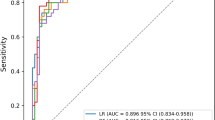Abstract
In medical emergencies, one of the areas where immediate and rapid response is required is known as brain hemorrhages. It is a severe condition where a slight delay in diagnosis can result in the loss of life. Thus, for faster processing and taking second opinions, several computer-aided diagnosis (CAD) systems were explored in medical emergencies. The past works, in the machine learning domain, used the single modality-based features analysis for abnormality representation in CAD systems. This feature set was evaluated as a limited feature contributor in machine learning as hemorrhages are not associated with any specific shape, size, and texture information. By this motivation, the presented work explored the large-scale multivariate features pool for representing the hemorrhages properly. The proposed feature extraction phase can extract an overall 44 features of different domains which can be further evaluated by using various machine learning classification models. The experimentations are conducted on the hemorrhage dataset having 200 samples classified in binary form. In experimentation, three machine learning models, i.e., KNN, SVM, and neural network, are tested on various feature set combinations to find relevant features used for better interpretation of hemorrhages. The comparative result of these classifiers on various parameter settings proves the efficacy of the model.
Access this chapter
Tax calculation will be finalised at checkout
Purchases are for personal use only
Similar content being viewed by others
References
Vidyarthi A, Agarwal R, Gupta D, Sharma R, Draheim D, Tiwari P (2022) Machine learning assisted methodology for multiclass classification of malignant brain tumors. IEEE Access
McGurgan IJ, Ziai WC, Werring DJ, Salman RAS, Parry-Jones AR (2021) Acute intracerebral haemorrhage: diagnosis and management. Pract Neurol 21(2):128–136
Vidyarthi A, Agarwal P, Mittal N (2014) Machine learning based classification of high grade malignant brain tumors using diverse feature set. In: 2nd international conference on advances in computing and information technology (ICACIT)
Zhang J, Qi H, Ji Y, Ren Y, He M, Mingxu S, Cai X (2021) Nonlinear acoustic tomography for measuring the temperature and velocity fields by using the covariance matrix adaptation evolution strategy algorithm. IEEE Trans Inst Meas 71:1–14
Pisner DA, Schnyer DM (2020) Support vector machine. In: Machine learning. Elsevier, pp 101–121
Arbabshirani MR, Fornwalt BK, Mongelluzzo GJ, Suever JD, Geise BD, Patel AA, Moore GJ (2018) Advanced machine learning in action: identification of intracranial hemorrhage on computed tomography scans of the head with clinical workflow integration. NPJ Digital Med 1(1):1–7
Liu J, Haoli X, Chen Q, Zhang T, Sheng W, Huang Q, Song J, Huang D, Lan L, Li Y et al (2019) Prediction of hematoma expansion in spontaneous intracerebral hemorrhage using support vector machine. EBioMedicine 43:454–459
Muschelli J, Sweeney EM, Ullman NL, Vespa P, Hanley DF, Crainiceanu CM (2017) Pitchperfect: primary intracranial hemorrhage probability estimation using random forests on CT. NeuroImage: Clin 14:379–390
Ray S, Kumar V (2020) Derived shape features for brain hemorrhage classification. In: Soft computing for problem solving. Springer, pp 431–442
Shahangian B, Pourghassem H (2016) Automatic brain hemorrhage segmentation and classification algorithm based on weighted grayscale histogram feature in a hierarchical classification structure. Biocybernetics Biomed Eng 36(1):217–232
Malik P, Vidyarthi A (2022) A deep learning assisted image-guided framework for differentiation among tumors and hemorrhages in head imaging. Comput Electr Eng 103:108330
Grewal M, Srivastava MM, Kumar P, Varadarajan S (2018) Radnet: radiologist level accuracy using deep learning for hemorrhage detection in CT scans. In: 2018 IEEE 15th international symposium on biomedical imaging (ISBI 2018). IEEE, pp 281–284
Gou X, He X (2021). Deep learning-based detection and diagnosis of subarachnoid hemorrhage. J Healthc Eng 2021
Mushtaq MF, Shahroz M, Aseere AM, Shah H, Majeed R, Shehzad D, Samad A (2021) Bhcnet: neural network-based brain hemorrhage classification using head CT scan. IEEE Access 9:113901–113916
Author information
Authors and Affiliations
Corresponding author
Editor information
Editors and Affiliations
Rights and permissions
Copyright information
© 2023 The Author(s), under exclusive license to Springer Nature Singapore Pte Ltd.
About this paper
Cite this paper
Malik, P., Vidyarthi, A. (2023). A Large-Scale Multivariate Features-Based Classification of Brain Hemorrhage Using Machine Learning Algorithms. In: Swaroop, A., Kansal, V., Fortino, G., Hassanien, A.E. (eds) Proceedings of Fourth Doctoral Symposium on Computational Intelligence . DoSCI 2023. Lecture Notes in Networks and Systems, vol 726. Springer, Singapore. https://doi.org/10.1007/978-981-99-3716-5_9
Download citation
DOI: https://doi.org/10.1007/978-981-99-3716-5_9
Published:
Publisher Name: Springer, Singapore
Print ISBN: 978-981-99-3715-8
Online ISBN: 978-981-99-3716-5
eBook Packages: Intelligent Technologies and RoboticsIntelligent Technologies and Robotics (R0)




